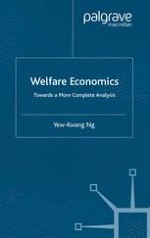2004 | Buch
Über dieses Buch
Yew-Kwang Ng looks to make welfare economics more complete by discussing the recent inframarginal analysis of division of labour and by pushing welfare economics from the level of preference to that of happiness, making a reformulation of the foundation of public policy necessary. A theory of the third best is provided, with extension to the equality/efficiency issue. The remarkable conclusion of treating a dollar as a dollar provides a powerful simplification of public policy formulation in general and in cost-benefit analysis in particular.
Anzeige
